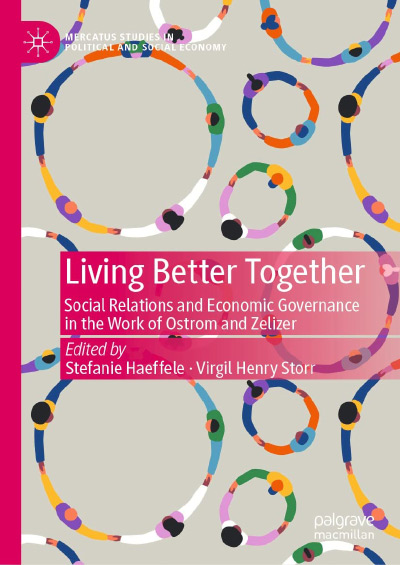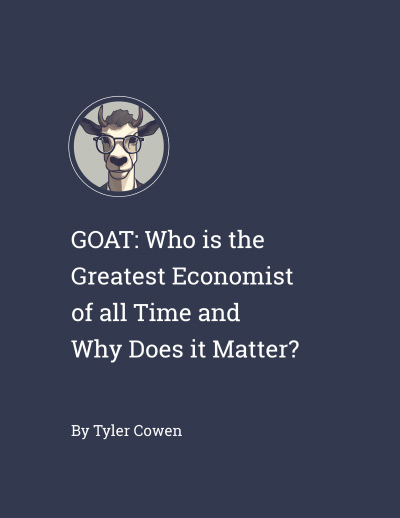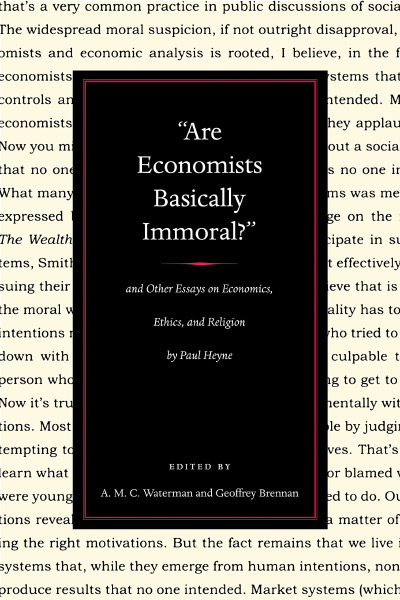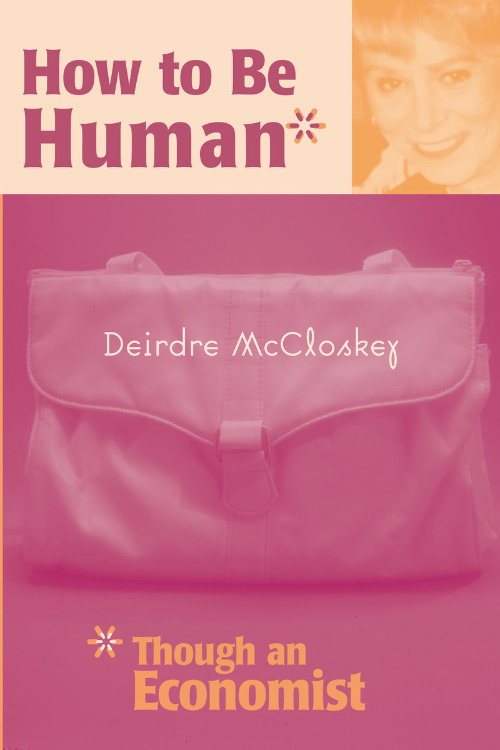Readers of The Independent Review are familiar with the contributions that Elinor Ostrom, 2009 Nobel laureate, made to our understanding of self-governance. Economic Sociologist Viviana Zelizer’s work should be considered alongside Ostrom’s description of how decentralized human actors work to encourage cooperation and problem solving outside of traditional government and market dichotomies. This volume by Stefanie Haeffele and Virgil Henry Storr makes the case that the two methodologies complement each other. The book is a product of the Mercatus Center’s Studies in Political Economy series.
Both Ostrom and Zelizer recognize limits to solving problems from an aggregate perspective. Ostrom’s contribution to political economy centers on Common Pool Resources (CPRs) managed by local actors who rely on institutional entrepreneurs to coordinate groups. Zelizer combines the best insights from economics and sociology to account for how disciplinary separation has limited our insight into relationships at the most disaggregated level. The image of a lighthouse symbolizes public goods that are created by private actors, and it is that image that is on the cover of this journal. Zelizer’s work on emergent networks and circuits of commerce simply expands our explanatory toolkit for how such private cooperation occurs.
Haeffele and Storr’s volume is remarkably diverse in terms of disciplinary methodology. The most numerous group are economists, but scholars in cultural economics, political theory, political science, history, archeology, architecture, public administration, and gender and sexuality studies are included, as well. Each of their chapters in the volume either emphasizes a methodological synthesis between the two authors or an application.
Haeffele and Storr introduce the volume by stating that individuals face cognitive and epistemic limits which explains why complex social systems arise to accommodate these limits. Benevolence, or true concern for others, is also scarce, so humans allocate benevolence where it is expected to nurture reciprocity. For both Ostrom and Zelizer these reciprocal and relational networks between people require emphasis on the role of informal institutions in social coordination. Ostrom provides a clear description of governance organizations arising in highly functional informal groups. Zelizer clarifies the social side of how entrepreneurs leverage functional social relationships to form these groups. She rejects any notion that economic and social relationships are separate, hostile to one another, or that either one can simply be ignored.
Vivianna Zelizer’s contribution to the volume discusses both her approach and some meaningful overlap with Ostrom. Fieldwork was important for both, “insisting that abstract models be grounded in observations of real people involved in economic activity” (p. 13). Embeddedness is an important feature of this approach. Individual choice is part of the story, but Zelizer takes social structures, like social circuits, seriously. The individual joins groups that influence their choices and that context matters.
Carolina Dalla Chiesa, Valeria Morea, and Francesca Sabatini unpack Ostrom’s institutional approach to studying commons before they explain how Zelizer’s understanding of circuits of commerce relies on a polycentric view of human behavior. Actors are embedded in multiple circuits at once, which explains why cooperation can occur from the ground-up in a way that makes traditional dichotomies of market and state insufficient to capture the complexity of what is being described in social science. They comment: “The study of governance systems can greatly benefit from unveiling how better government systems are possible because of strong ties, intimacy, and overall shared norms and rules” (p. 66). This context gives substance to Ostrom’s institutional entrepreneurs because it explains how cooperation is forged.
Jayme Lemke combines the insights from Ostrom and Zelizer to explain bottom-up social coordination. She shows how both authors can be used to understand the evolution of rules and norms, specifically with the rapidly changing rights of women in the nineteenth and early twentieth century. Ostrom’s commitment to rejecting a market vs. government dichotomy connects with Zelizer’s rejection of the same. Zelizer describes norms as a narrative process and as norms change the institutions also adapt to solve evolving collective action problems. Ostrom’s approach focused on formation of governance, but not the adaptation of that governance over time. Lemke gives an example of this adaptation. Rules and norms that cannot be defended erode through neglect. New groups form around new norms that better serve their goals.
Laura Grube explains how both Ostrom’s and Zelizer’s frameworks provide insight into disaster recovery outside of formal government responses or narrowly defined market institutions. Membership in religious groups, for example, can help to explain the choice to return and rebuild after a disaster. Heterogeneous groups with strong neighborhood affinity, or shared narrative, also rebound well after a disaster. Grube’s chapter highlights the importance of Ostromian questions about institutional resilience and the descriptive merit of Zelizer’s approach to understanding the networks that make those resilient institutions possible.
Jennifer Hudson explores the formation of governance institutions during the Syrian civil war. While her chapter offers a clear application of Ostromian private governance, the additional perspective of comparing rival non-government groups bears a resemblance to Zelizer’s approach. While some non-government groups form to provide public goods of cooperation, other (armed) groups create public bads through rent-extraction that undermines cooperation. Civilians are torn between these competing groups. Both groups function according to circuits of social relationship, and thinking carefully about how each group maintains “cooperation” is a great application of the Zelizer-Ostrom approach to a complex example of wartime conflict. Ostrom can explain the survival of cooperative institutions, but Zelizer might help explain how rival circuits can form and endure that are rent-extractors and antagonistic to public good provision.
Hannah Knox Tucker discusses an important example of social networks, letter delivery in the eighteenth century British Colonial experience. The formal system was dysfunctional enough that private systems arose through networks of ship captains and business owners. Another system existed for the members of the African diaspora that were not part of this rival informal system. Zelizer’s circuits of commerce help explain these overlapping systems of communication, and why captains were motivated to provide mail service at radically lower costs than the imperial system. The polycentric system operated along the lines that Ostrom would recognize because of the role of captains and business owners as institutional entrepreneurs with extra-pecuniary reasons to cooperate.
Brianne Wolf focuses specifically on the family as an institution that is underdeveloped in the literature that relies on dichotomies of individual or micro-action and collective or macro-action. The family is complex because it is both an expression of heterogeneous partiality and a limit on individuality. The choices of individuals are considered in microeconomics and framing this in terms of the family isn’t directly useful in understanding marginal choices of individuals in economics. Instead, idiosyncratic preferences are normally taken as given, but a Zelizer approach understands the influence family as a circuit has on the formation of these preferences. To simply aggregate to the scale of macroeconomics would lose the role the family plays in the evolution of norms.
Minjun Yuan and Wanlin Lin offer a compelling example of online markets in developing countries that do not yet have the rich formal infrastructure of markets and rely instead on polycentric social networks to form patterns of exchange relationships. Emergent online institutions are a novel and exciting contemporary application of the work that this volume is focused on. Establishing a trusted third party online helps to create governance, but such governance must build on underlying social networks that are essential for quality feedback. One threat, fake reviews, weakens the legitimate networks, guanxi, by replacing them with artificial ones. Real-world social networks at the core of these exchange relationships help to defend against opportunism.
Victoria Reyes, Crystal Dozier, Anne Hobson and Stefanie Haeffele, and V. Miranda Chase all contribute applications of the Zelizer approach to studying their own fields. Reyes gives an institutional analysis of the academy that helps explain disciplinary boundaries as a limit on coordination in the social sciences. Political science stands out as a field that is more open to interdisciplinary work. Dozier shows that Zelizer provides a great taxonomy for understanding southern plains economies from 1350 to 1700. An advanced disaggregated network of cities resulted in advanced urban clusters without a central government organizing and regulating commerce. Hobson and Haeffele report on survey data among the Cuban diaspora about remittances which benefit from thinking about economic circuits. Complex hurdles to sending and receiving remittances are overcome through thick social ties. The social ties also help explain migration decisions and domestic patterns of inequality. Chase describes how outsiders are vetted when attempting to support Brazilian environmental protestors who are threatened by logging companies. Thinking about how different monies are treated helps understand the gifts given to activists experiencing displacement due to threats.
Overall, the volume is a fruitful collection of essays that build on a synthesis between Zelizer and Ostrom. The diverse views in this volume all come together to point at interdisciplinary work that can be done in light of these approaches. Not only does the volume provide many different methodological reasons to renew our interest in bottom-up development of social networks, but it also provides examples of how diverse academic disciplines can create a common language to share their insights on related phenomena.
| Other Independent Review articles by Michael D. Thomas | ||
| Fall 2020 | Markets against Modernity: Ecological Irrationality, Public, and Private | |
| Spring 2018 | The Rise of the Regulatory State: Institutional Entrepreneurship and the Decline of Markets for Blood | |
| Spring 2018 | Inside Job: How Government Insiders Subvert the Public Interest | |
| [View All (4)] | ||



















